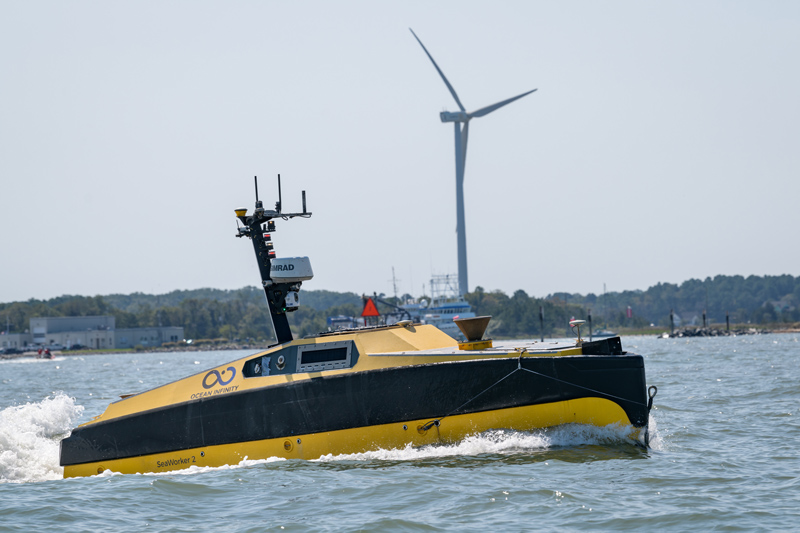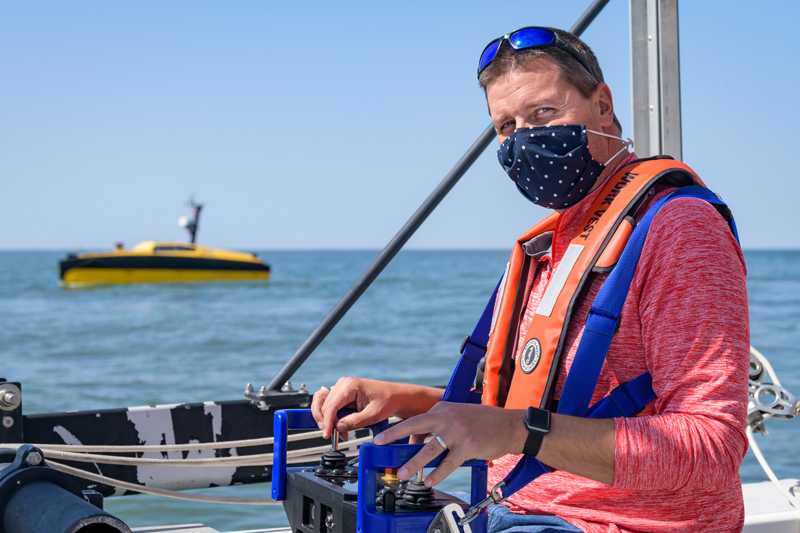


Robot boats
Photos by Evan Krape October 30, 2020
Industry partnership adds four autonomous surface vessels for research and teaching at UD
Four Autonomous Surface Vessels (ASVs) have arrived at the University of Delaware courtesy of Ocean Infinity (OI), a leading marine robotics company that signed a memorandum of understanding with the university in 2018.
Stationed at UD’s Hugh R. Sharp campus in Lewes, the 24-foot long ASVs, which look similar to speed boats, will allow for hands-on learning and research opportunities for students and faculty in UD’s College of Earth, Ocean and Environment (CEOE) as they collaborate with OI to advance the capabilities of the technology.
While OI originally envisioned the ASVs to work in tandem with their fleet of Autonomous Underwater Vehicles (AUVs), it became apparent that while they worked well together for certain purposes, for other purposes, it was more efficient to use them separately.
The ASVs, for example, can be used to focus on shallow water surveying and near shore projects, such as offshore wind, oil and gas projects, whereas the AUVs were more suited to the deep-water projects.
One of the goals of having the vessels at UD is to try to unlock their capabilities and discover how and in what areas they work best.
“This partnership gives us an opportunity to work alongside the University and learn from what they’re learning,” said Josh Broussard, the chief technology officer for OI. “Likewise, what we’re seeing in industry, we can take back to the University. To me, it’s about partnership, being able to work together with other experts in the field and share knowledge and try to grow that autonomous technology together.”

Art Trembanis is a professor in CEOE’s School of Marine Science and Policy who has been integral in fostering the relationship with Ocean Infinity, and he said that as far as he knows, there is no other academic group in the world with one of these vessels, let alone four.
“Getting access to this equipment is incredible. Each of these systems could be a treasure trove for our students,” said Trembanis. “It opens up new research and funding potentials for us on our side, and it opens new opportunities for Ocean Infinity to advance their technology. It really is a win-win and a chance to highlight our college’s robotics hub that we are working hard to build and maintain.”
Unlocking the robots’ potential
Since the technologies on the ASVs are so new, there are several things that need to be worked out or improved. The difficulty for OI is that it doesn’t make business sense to test the new capabilities of these vessels or new sensors on the vessels when they are out on the water working on other operations.
Bryan Keller, who received his master’s degree from UD in 2011 as a student in Trembanis’ lab and now works with OI as an AUV/ASV operator, said the partnership allows OI to innovate while not cutting into their work schedule.
“Allowing the University use of these boats with our support allows us to do our research and development as well as testing of our systems without cutting into our production,” said Keller. “This way, we can use UD to test out new sensors first and potentially use that as a commercial product later. That’s where this partnership helps, on the innovation side of things.”
The partnership will be particularly beneficial in trying to unlock the capabilities of the ASVs in shallow water environments, which Trembanis said is his area of expertise.
“We do all of our research in ultra-shallow waters like our inland bays,” said Trembanis. “We can develop ideas, we can test it, integrate new sensors and behaviors, put them through paces and then with those modifications and improvements, those research and development efforts can be propagated back into the larger Ocean Infinity fleet.”
These ASVs bring with them a great opportunity for UD researchers and students because they can run in the water for five to six days continuously under a variety of conditions and are designed to cover big areas — technological capabilities to which UD did not have previous access.
These ASVs also have tools that allow them to operate and perform tasks that are usually carried out by larger research vessels. They can be outfitted with different sensors, capable of measuring the temperature of the water column, wind characteristics and plastics. For mapping purposes, they are equipped with multibeam sonar, as well as color and infrared cameras.
Having the four ASVs at UD will allow researchers to look at their behaviors when they perform operations together.
“We want to improve their intelligence — how they operate with their surroundings and with each other,” said Trembanis. “We want them to be more aware of their surroundings so they can operate more autonomously. We want them to be able to work with the data they’re collecting and make decisions in real-time knowing, ‘Oh, I just saw something in my data that I want to inspect’ or ‘I’m not getting all the coverage I need’ and adjusting the lines on their own.”
Strategic Location
For OI, in addition to having the UD researchers and students helping improve the technology, operating out of Lewes gives them a strategic position in the Mid-Atlantic region.
The ASVs can be used by the company to do commercial projects up and down the coast, from Massachusetts to North Carolina.
But for all these additional benefits, Trembanis stressed the most important part of the partnership is the benefit for the students.
“We’re trying to focus this to make sure we get students engaged and involved because it builds a pipeline to employment with these companies and it gives them an advantage of having access to these technologies,” said Trembanis.
Keller said having those industry connections when he was a graduate student at UD allowed him to obtain his current position with OI.
“UD gave me the connection side of things. I met people that introduced me and gave me industry opportunities,” said Keller. “That’s something that I wouldn’t have gained some of the other universities I could have attended.”
Contact Us
Have a UDaily story idea?
Contact us at ocm@udel.edu
Members of the press
Contact us at 302-831-NEWS or visit the Media Relations website

